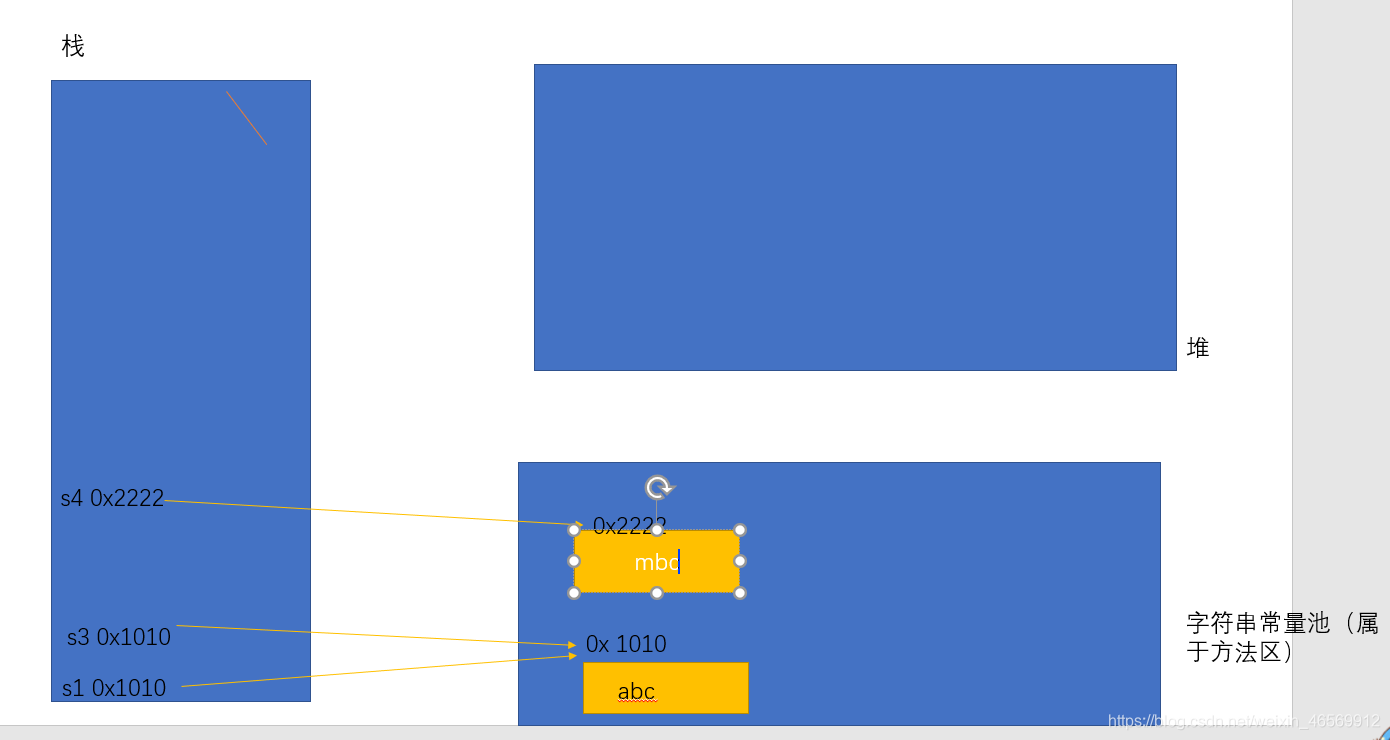一、String的不可变性,实例化的两种方式以及预备知识
1.String的不可变性:
String是一个final类,不可被继承所以其字符序列不可变,
String对象的字符内容是存储在一个字符数组value[]中的,字符串是常量,创建之后不能更改
String的声明为下图:
2.String实例化的两种方式:
①通过字面量定义的方式
②通过new+构造函数的方式
3.预备知识:内存解析
堆:此内存区域的唯一目的就是存放对象实例,几乎所有的对象实例都在这里分配内存。
栈:即虚拟机栈,用于存储局部变量等。局部变量存放了编译期可知长度的各种基本数据类型(boolean,byte,char,short,int,float,double,long等),对象引用(不等同于对象本身,是对象在堆内的首地址)方法执行完自动释放。
方法区:用于存放已被虚拟机加载的类信息,常量(常量池),静态变量,即时编译器编译后的代码等数据。
二、字面量定义实例化
public class 字面量实例化 {
public static void main(String[] args) {
String s1="abc";//字符串常量存储在字符串常量池里,目的是共享,并且字符串常量池中是不会存储相同内容的字符串的。
//即s1,s2在栈中为一项,二者常量池指的是同一常量
String s2="abc";
String s3="111";
System.out.println(s1==s2);//true,比较的是常量池中的地址
s1="111";//value数组为final类型,所以不能对现有数组进行重新赋值,故新添加常量
System.out.println(s1);//111,重写了指定内存区域赋值,指向字符串常量池中新添加的常量111
System.out.println(s1==s2);//false,111和abc分别表示不同的内存区域,所以不相等。
System.out.println(s1==s3);//true,指向相同的内存区域,所以相等
System.out.println("*****************");
String s4="abc";
s4+="456";//经试验发现s4进行连接运算后,s2并未发生变化,所以s4依然是新创建的
System.out.println(s4);//abc456,重写了指定内存区域赋值,重新指向内存区域赋值
System.out.println(s2);//abc
System.out.println("*****************");
String s5="abc";//经试验发现调用了replace()方法后,s5值依旧保持不变,所以s6新创建的
String s6=s5.replace("a","m");//重写了指定内存区域赋值,重新指向内存区域赋值
System.out.println(s5);//abc
System.out.println(s6);
}
}
以上代码图片解析如下:
String s1=“abc”;
String s2=“abc”;
String s1=“abc”;
String s2=“abc”;
s2=“111”;
String s4=“abc”;
s4+=“456”;
String s3=“abc”;
String s4=s3.replace(“a”,“m”);
小结论:
字符串常量存储在字符串常量池里,目的是共享,并且字符串常量池中是不会存储相同内容的字符串的。
①当对字符串重新赋值时,需要重新指定内存区区域赋值,不能使用原有的进行赋值
②当对现有的字符串进行连接操作时,也需要重新指定内存区域赋值,不能使用原有的进行赋值
③当调用String的replace()方法修改指定字符或者字符串时也需要重新指定内存区域
String是不可变类型的,对它进行修改都需要重新造。
三、new+构造函数实例化
public class new实例化 {
public static void main(String[] args) {
String s3=new String("abc");字符串非常量对象存储在堆中,s3,s4保存的地址值,是数据在堆空间中开辟以后对应的地址值
String s4=new String("abc");
String s1="abc";
String s2="abc";
System.out.println(s1==s2);//true
System.out.println(s1==s3);//false
System.out.println(s1==s4);//false
System.out.println(s3==s4);//false
}
}
以上代码图片解析如下:
public class Student {
String name;
int age;
public Student(){
}
public Student(String name,int age){
this.age=age;
this.name=name;
}
public static void main(String[] args) {
Student s1=new Student("小贾",18);
Student s2=new Student("小贾",18);
System.out.println(s1.name.equals(s2.name));//true
System.out.println(s1.name==s2.name);//true
}//字符串非常量对象存储在堆中,s3,s4保存的地址值,是数据在堆空间中开辟以后对应的地址值,对象中的string属性存储在字符常量池中
}
代码运行结果如下:
以上代码图片解析如下:
四、String拼接操作对比
public class 测试类 {
public static void main(String[] args) {
String s1 = "abc";
String s2 = "1234";
String s3 = "abc1234";
String s4 = "abc" + "1234";
String s5 = s1 + "1234";
String s6 = "abc" + s2;
String s7=s6.intern();
System.out.println(s3 == s4);//true
System.out.println(s3 == s5);//false
System.out.println(s3 == s6);//false
System.out.println(s5 == s6);//false
System.out.println(s7== s3);//true
}
}
代码运行结果如下:
小总结:
①常量与常量的拼接结果还在常量池中
②拼接双方只要有一个是变量,结果就在堆中,就new了
③若拼接结果调用String中的intern()方法,能把返回值转换成常量池中存在的结果
新手上路,因能力有限,若有不足之处还望大家海涵!










